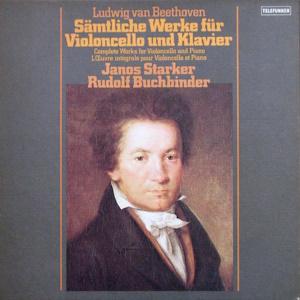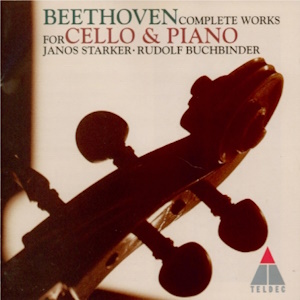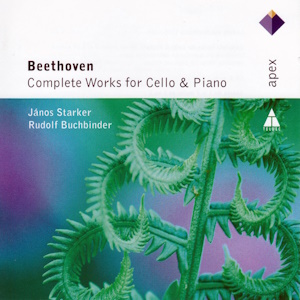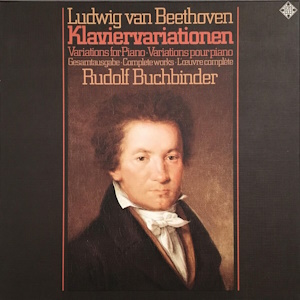 |
|
3 LPs
- 6.35450 EX - (p) 1978
|
 |
| 2 CDs -
0630 17368-2 - (p) 1997 |
 |
| 2 CDs -
2564 69223-7 - (p) 2009 |
|
| SÄMTLICHE
WERKE FÜR VIOLONCELLO UND KLAVIER |
|
|
|
|
|
|
|
| Ludwig van BEETHOVEN
(1770-1827) |
|
|
|
|
|
|
|
Sonate
Nr. 1 F-dur für Klavier und
Violoncello, Op. 5 Nr. 1 - dem
König Friedrich Wilhelm II. von
Preußen gewidmet
|
|
20' 57" |
A
|
-
Adagio sostenuto · Allegro
|
14' 12" |
|
|
| -
Rondo. Allegro vivace |
6' 35" |
|
|
| Sonate
Nr. 2 g-moll für Klavier
und Violoncello, Op. 5 Nr.
2 - dem König Friedrich
Wilhelm II. von Preußen
gewidmet
|
|
24' 57" |
B |
-
Adagio sostenuto ed espressivo ·
Allegro molto più tosto presto
|
23' 50" |
|
|
| -
Rondo. Allegro |
9' 07" |
|
|
|
|
|
|
| Sonate
Nr. 3 A-dur
für Klavier
und
Violoncello,
Op. 69 - dem
Freiherrn Ignaz
von Geischenstein
gewidmet
|
|
23' 53" |
C |
| -
Allegro ma non tanto |
9' 32" |
|
|
-
Scherzo. Allegro molto
|
5' 39" |
|
|
-
Adagio cantabile · Allegro vivace
|
8' 42" |
|
|
| Sonate
Nr. 4 C-dur
für Klavier
und
Violoncello, Op. 102 Nr. 1 - der Gräfin
Marie von
Erdödy
gewidmet
|
|
15' 19" |
D1
|
| -
Andante · Allegro vivace |
8' 08" |
|
|
| -
Adagio · Allegro vivace |
7' 11" |
|
|
| 7
Variationen
Es-dur über
das Thema "Bei
Männern,
welche Liebe
fühlen", aus Mozarts "Die Zauberflöte"
für Klavier
und
Violoncello,
WoO 46 - der Grafen Johann Georg von
Browne
gewidmet |
|
10' 18" |
D2 |
-
Tema. andante
|
|
|
|
|
|
|
|
| Sonate
Nr. 5 D-dur
für Klavier
und
Violoncello, Op. 102 Nr. 2 - der Gräfin
Marie von
Erdödy
gewidmet
|
|
20' 32" |
E |
| -
Allegro con brio |
6' 50" |
|
|
| -
Adagio con molto sentimento
d'affetto |
9' 46" |
|
|
| -
Allegro · Allegro fugato |
3' 56" |
|
|
12
Variationen F-dur +ber "Ein
Mädchen oder Weibchen", aus
Mozarts "Die Zauberflöte" für
Klavier und Violoncello, Op. 66
|
|
9' 32" |
F1 |
-
Tema. Allegretto
|
|
|
|
12
Variationen G-dur über ein Thema
aus Händels Oratorium "Judas
Maccabäus" für Klavier und
Violoncello, WoO 45 - der
Fürstin Christiane von Lichnowsky
gewidmet
|
|
12' 48" |
F2 |
| -
Tema. Allegretto |
|
|
|
|
|
|
|
Rudolf BUCHBINDER,
Klavier (Bösendorfer-Flügel)
Janos STARKER, Violoncello
|
|
|
|
|
|
Luogo
e data di registrazione |
|
Teldec
Studio, Berlin (Germania) - 25/26
aprile 1978
|
|
|
Original
Editions |
|
Telefunken
| 6.35450 EX | 3 LPs | LC 0366 |
durata: 45' 54" · 49' 30" · 42'
52" | (p) 1978 | ANA | stereo
|
|
|
Edizioni CD
|
|
Teldec
| 0630-17368-2 | 2 CDs | LC 6019 |
durata 68' 27" ·
69' 31" | (c) 1997 |
ADD | stereo | Remastered
Warner
Classics "Apex" | 2564 69223-7 |
2 CDs | LC 04281 | durata 68' 31
·
69' 33"
| (c) 2009 | ADD |
stereo | Remastered |
|
|
Executive
Producer |
|
Heinrich
J. Weritz
|
|
|
Recording
Producer and Tonmeister |
|
?
|
|
|
Recording
Engineer |
|
?
|
|
|
Cover |
|
Ludwig
van Beethoven, Gemälde von J. W.
Mähler, 1815
|
|
|
Art Direction
|
|
?
|
|
|
Note |
|
- |
|
|
|
|
|
BUCHBINDER
& BEETHOVEN

6 LPs - 6.5289 FK - (p) 1976
 6 LPs - 6.35368 FK
- (p) 1977
6 LPs - 6.35368 FK
- (p) 1977

3 LPs -
6.35450 EX - (p) 1978
|
Complete
works for cello and piano
The laws of art are often
unfathomable; not infrequently its
further paths, its fate, appear to
he even more unfathontable. This
once again becomes evident From
the Beethovcn cello works which
even still today - particularly as
an integrated unit - tend to be
regarded as a part of the unknown
Beethoven. The especial element of
Beethoven's autograph works
deserved interest in certain part
sectors. and this is most
definitely the case with the works
introduced here; for in their own
way they provide an indication of
Beethoven's general compositional
development. A new aspect is
treatment of the instrumental duet
as such, but a further new element
is Beethoven's method towards
simultaneous creative work in
other fields. The two last sunatas
op. 102 are unparalleled works
which, composed at such an early
period, point to a style in the
far distant future.
"Deux Grandes Sonates pour le
Clavecin ou Pianoforte avec un
Violoncelle obligée" is the title
of the two sonatas op. 5. In this
connection the noteworthy point is
not only that the cello - contrary
to present-day understanding -
does not appear as accompanying
instrument to the piano, but that
there is express reference to
obbligato application. This is a
rejection of the old baroque
practice of a solo instrument with
basso continuo accompaniment, with
corresponding liberties of the
accompanist as his own
contribution. That this reference
in the present edition was not a
mere coincidence is apparent from
Beethoven's more express
instructions in a different
context. Just a few years later he
wrote to the Leipzig publisher
Hoffmeistet concerning the parts
of his septer op. 20: "Tutti
obligati. (I cannot write anything
non-nbbligato because l already
came into the world with an
obbligato accompaniment". Thus
Beethoven was less concerned with
creating a fundamentally fresh
style for the cello sonata, than
coining a new form of the solo
sonata with two firmly
interrelated instrumental parts;
over and above this, the cello
departed from its heterogeneous
function of mere reinforcement of
the bass and was given a
self-sufficient and independent
significance. As regards
individual works, it is always
advisable to enquire as to the
particular occasion. Beethoven had
written the op. 5 sonatas in 1796
during a visit to Berlin for
Pierre Duport, the first cellist
of the Prussian Court Orchestra.
and performed it together with him
at the court. In his way he
probably took to heart what
Christian Friedrich Daniel
Schubart had once said about
Duport: "He plays the violoncello
with such magic power that it is
difficult to find anybody in Europe
to equal him. He guides the bow as
in a storm and rains down notes.
He rises above and beyond the
extreme heights of the fingerboard
and finally disappears in the
rnost delicate harmonics“.
Incidentally King Friedrich
Wilhelm II of Prussia, to whom the
sonata was dedicated, was also an
expert in this field; he enjoyed
Duport's tuition and was regarded
as a diligent cellist and keen
chamber music player.
As is the case with most of the
piano works. the cello works are
also orientated to the forms of
the sonata and of the theme with
variations. The sonatas op. 5 bear
their own stamp in so far as each
consists of two movements and
waives the usual slow middle
movement as well as the scherzo;
both have an adagto introduction
as the opening movement, and a
rondo as the concluding movement.
In his endeavour to bring the
cello more strongly into the
foreground, Beethoven by no means
neglected the piano part, as one
can already see at the beginning
of the 1' sonata. At the end of
the brief adagio introduction it
makes a brilliant impression with
a wide-ranging cadenza-like
passage. But even the allegro
beginning which immediately
follows on indicates that the
piano is allotted the task,
appropriately accorded to the
orchestra in instrumental
concrtos, of guiding the themes of
the solo. Furthermore there are
themes which appear to be inspired
purely and simply by the cello -
passages and cantilenas at any
rate which in all positions are
able to emphasise the unmistakable
singularity of the instrument.
Beethoven had always been a master
of the art of contrasts and
especially so when it was a matter
of such markedly individual
characters such as the piano and
cello. This contrast-related
design is rnost effective in the
mobile forward-pressing first
theme compared to the retarding
syncopated beats of the second
theme. The conspicuous thematic
diversity, which incidentally the
two sonatas have in common,
results in Beethoven to a large
extent abandoning his usual
technique of motif and thematic
development in favour of freer and
more imaginative progress.
In many respects the second sonata
already seems to be somewhat
further developed; although
featuring several common aspects
in the overall attitude, it
nevertheless displays a noticeable
increase in expression. From the
outset, the beginning recalls the
mood of the pathos-laden piano
sonatas which are so typical of
Beethoven; we hear mighty chords
and dotted rhythms which are
further developed throughout the
entire introduction. The lively
dialogue between the two
instruments at the beginning of
the allegro makes a most charming
impression, especially in
preparation of the spirited focal
point which is accompanied by
piano triplets. The most genuine
Beethoven is quite clearly heard
in the concluding rondo, a
delightful sample of his
much-lauded humour, as if created
specifically for the virtuoso arts
of an executant of Duport’s
calibre. It reminds the listener
of Beethoven’s frequently
expressed preference for swelling
finales.
No detailed information has been
passed on concerning the
Beethoven-Duport performance. With
the Sonata in A major op. 69,
composed more than ten years
later, Beethoven most probably
wanted to compensate his friend
Ignaz von Gleichenstein, for whom
the Piano Concerto in G major op.
58 was originally intended but to
whom it was not, in fact,
subsequently dedicated.
Gleichenstein was by profession a
planner at the royal and imperial
court war council, as was also
Beethoven's friend Stephan von
Breuning. Beethoven appreciated
Gleichenstein for his education,
his kind-heartedness and also on
account of his excellent cello
playing. The diverse pastimes of
the two friends went as far as a
joint search for a bride.
Gleichenstein was tactful enough
not to want to be immortalised
with his official title in the
first edition of the work; this
can be seen from the
correspondence between Beethoven
and his publisher. Dedication of
the work to Gleichenstein may have
prompted Beethoven to reduce the
virtuoso demands somewhat -
something which he was able to
make up for in other sectors.
Right from the beginning the cello
alone is heard playing a splendid
melody, an absolutely first-class
example of the instruments
beautiful sonorous depths. The
fact that the thematic sequence of
this sonata to a large degree
renounces contradictory elements
should not be prematurely
construed as a weakness in the
work. At least in a clear
indication of self-reliance in the
cello part we observe a sign of
increasing maturity. The only
astounding aspect is how the Fifth
Symphony, a completely different
type of work, with its extremely
compulsive germinating motif
developments, could have been
composed in the same creative
phase as this cello sonata, as is
evident from an examination of the
sketches. Worthy of particular
note is the scherzo, which already
has an unusually high standing
because of its external
dimensions: 519 bars compared with
280 bars in the opening movement
and 220 in the finale. In this
case too an adagio is limited to a
brief introduction into the finale,
a period of quiet before the storm
which appears to have more of an
interim function than a
significance of its own.
Beethoven’s correspondence with
his publisher concerning this
sonata proves, inter alia, the
importance of the dynamic marks in
which even Beethoven himself did
not always seem to be infallible.
In a letter dated 3 August, 1809
for instance he writes: "Do not
laugh about my author-like
apprehension. Just imagine, I find
that in correcting the mistakes in
the violoncello sonata I have made
new errors. Therefore: in the
scherzo allegro molto this ff
remains as it was indicated in the
first places". - And indeed the
scherzo does not live too frugally
from the dynamic refinements.
Personal relationships are also
associated with the two sonatas in
C major and D major op. 102. They
were dedicated to Countess Marie
Erdödy and evidently intended for
her and the cellist Joseph Linke
who was closely connected with her
music-loving home. Beethoven’s
cordial relations with this
countess are reflected in numerous
letters which have been preserved.
But precisely at this point the
question has to be asked as to how
much the dedication of these works
has to do with her singular
figure. Even contemporaries did
not refrain from expressing fitting
criticism. The "Allgcmeine
Musikalische Zeitung" of 11
November, 1818 wrote: "These two
sonatas are quite definitely among
the most unusual and peculiar
written for the pianofotte for a
long time, not only in this form
but generally. Everything here is
different, quite different. from
what we have otherwise received,
even from this master himself. We
trust he will not take it amiss if
we add that not a little as it is
written here now, and as it is
arranged, published and
distributed, also appears to be
designed in such a way that it
will emerge in a quite unusual,
quite strange fashion". What was
attracting adverse criticism here
in its initial stages was nothing
else but Beethoven's late style.
now appearing ro an increasing
extent, about the unfavourable
reception of which he himself had
no illusions; for a little while
later he countered complaints
about the disagreeable, difficult
style of his piano sonata op. 101
with his own philosophy that
"difficult" was a relative term,
but that for the rest the maxim
applied: "what is difficult is
also beautiful, good, great etc.
Every man will therefore see that
this is the biggest praise that
one can give, since what is
difficult makes one eweat".
The departure from the
well-trodden paths is most
noticeable in the C major sonata
in as much as the usual cyclic
sequence is only hinted at in the
time changes with a corresponding
change in the musical course,
while basically the entire work
consists of a single
imagination-permeated movement. In
addition to this the motif and
thematic development remains
extremely free and unbound.
Beethoven, evidently quite
intentionally, replaces the
customary thematic compactness of
his thoughts by an often seemingly
stereotyped, short-winded
motif-thematic entity which the
two instruments play towards each
other at brief intcrvals,
occasionally even using stretto
style. This is effected with a
generally unmistakable tendency
towards that polyphonic manner of
composition which was to become so
typical of Beethoven’s late style.
Development is in many cases
shifted only to the rhythmic and
dynamic sectors. Similarly the so
characteristic trills of the late
piano sonatas and quartets are not
omitted in this strange game of
the, so to speak, disembodied and
spiritualised elements.
In many respects Beethoven takes a
somewhat more "conciliatory" line
in the second sonata. This appears
to be announced in the srnall.
compact melodic arc of the
introductory piano bars,
especially since this is continued
in a beautifully sweeping
cantilena on the cello. Once again
the whole is essentially a
richly-inspired fantasia, but this
time one with more marked concepts
and a longer range. A clear
pointer to the future are the
harmonic liberties in the
development which never before had
been experienced to this extent in
Beethoven's works. In the course
of greater compactness of the
individual sonata movements, a
slow movement is now also able to
achieve greater development. It is
one of those strongly expressive
adagios which were already to be
found in Beethoven's early piano
sonatas. Eight bars of solemn,
choir-like striding and
luxuriating in beautifully full
tones precede the momentous theme
declaiming "con molto sentimento
d'affetto", which appears
eminently to bring out the
expressive range of the
violoncello. A rhapsodic, free
further development of this
concept is joined by a simple,
initially song-like and then
variation-type part, in which the
illuminating major key has a
liberating and relaxing effect.
What then follows is a restrained
conclusion related to the
beginning.
By way of some timid, brief movcs
which recall the beginning of the
finale of the First Symphony, the
adagio proceeds directly into the
concluding movement, a
construction which probably is the
clearest anticipation of
Beethoven's late style. This is
one of Beethoven's so typical
mixtures of an initially strict
fugue - in this case in four parts
- with highly diverse motif
modification of individual
component parts. One enters a
world of abstract, constructivist
polyphony, with lively reminders
of Bach, in which the spirit of
the grand fugue clearly flares up
from the region of the last
quartet. Beethoven's apparent
struggle for new stylistic
possibilities is not the only
reason why these two sonatas are
accorded a key position in his
creative output. It also has to be
borne in mind that these are the
only two larger instrumental works
which Beethoven composed in this
particular year, 1815. A symphony
and a piano concerto did not get
beyond the planning stage at that
time.
In the normal course of events
Beethoven did not accord a great
deal of significance to his
variation works; as far as the
effort put into them was concerned
they sometimes hardly differed
from his extempore improvisations.
The outsider might evaluate them
differently. At any rate, most of
the variation works were
consciously not alloted opus
numbers. The reasons are obscure
as to how the variations on "Ein
Mädchen oder Weibchen" from
Mozart's "Magic Flutes" came to be
listed as opus 66. For all this,
the work does not take its place
between op. 65 and op. 67.
The twelve variations on a theme
from Handel's "Judas Maccabaeus"
were presumably composed in 1796,
the year in which the two sonatas
op. 5 were written. This was an
carly act of homage to the master
whom Beethoven greatly revered
throughout his life. This is also
reflected musically in occasional
conspicuous traits of the organ
toccata and the cottcerto gtosso,
as well as a tendency towards
polyphonic compositional style.
Beethoven most likelz became
acouainted with Handel's works in
the home of the art loving Baron
van Swieten in the early Vienna
years. A point worth mentioning
here is the independent role also
accorded in this case to the
cello.
Mozart's "Magic Flute" was one of
Viennaßs really big operatic
attractions at that time and thus
it is hardly surprising that
Beethoven on two occasions
composed variation-type
developments on themes from the
work. The twelve variations in F
major on "Ein Mädchen oder
Weibchen" were written in
connection with the original
edition, which appeared in
September, 1798, or probably just
before this. A notable point here
is that this time Beethoven
slightly altered the theme in as
much as he lets the second part -
which in Mozart's version is
written in 6/8 time - carry on in
the 2/4 time of the beginning.
Incidentally, this is the first
Beethoven work reviewed in the
famous "Allgemeine Musikalische
Zeitungt", albeit hardly to the
composerßs delight. What the
journal took amiss, however, was
not for instance Beethovenßs
arbitrary alteration of the theme,
but his all too bold modulations,
transitions and hardness,
particularly in Variation XII,
where he modulates from F major to
D major, then falling back again
to F major. Beethoven's merit as
regards the independent leading of
the cello was not one of the
questions which was dear to the
heart of the reviewer at that
time.
The seven variations on "Bei
Männern, welche Liebe fühlen"
prohahly owe their existence to
two extremely successful repeat
performances of the Magic Flute in
1801. With regard to these
variations. the reviewer thought
that they were not among the
excellent works usually expected
of Beethoven, but nevertheless
conceded: "Anybody wanting to
perform these cello parts must he
a consummate master of his
instrument".
As an example of Beethoverßs
variation compositions at that
time, these variations are of
intrinsic value in as much as they
were composed close to the time in
which the two famous piano
variations op. 34 and op. 35 were
written, which Beethoven himself
emphasised as being at the
crossroads of a completely new
trend marking the turn towards the
middle style period. In actual
fact, in several passages of the
afore-mentioned Magic Flute
variations one is reminded of op.
34.
by
Hans Schmidt
(English translation by
Frederik A. Bishop)
|
|
|
|